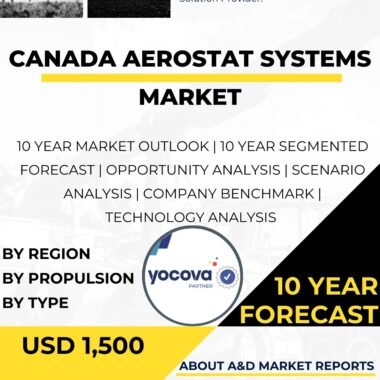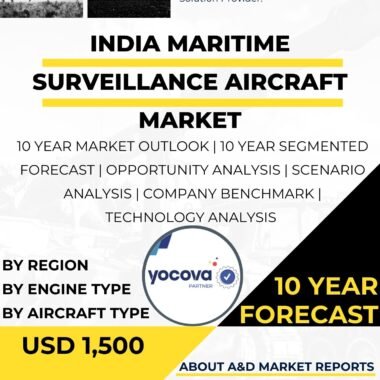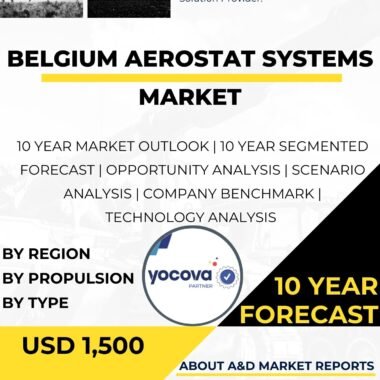Description
Maritime surveillance aircraft are specialized platforms designed to conduct reconnaissance and surveillance operations over vast oceanic areas and coastal regions. These aircraft are equipped with advanced sensors and systems to detect and track surface vessels, submarines, and maritime activities, making them vital assets for monitoring and securing maritime domains.
In the Netherlands Defense market, maritime surveillance aircraft play a critical role in safeguarding the country’s territorial waters, Exclusive Economic Zone (EEZ), and maritime interests. The Dutch Armed Forces utilize these aircraft to gather intelligence, detect potential threats, combat illegal activities, and support search and rescue (SAR) operations over the vast maritime territories under their responsibility.
One of the primary applications of maritime surveillance aircraft in the Netherlands is in ensuring maritime domain awareness. The Dutch Navy and Coast Guard deploy these aircraft to monitor maritime traffic, identify potential security risks, and combat illicit activities, such as drug trafficking and piracy. The data collected by these aircraft enhances the Dutch Armed Forces’ situational awareness and decision-making processes, enabling them to respond effectively to emerging threats and challenges in the maritime environment.
Moreover, the Netherlands Maritime Surveillance Aircraft market addresses the requirements of maritime search and rescue operations. These aircraft are equipped with state-of-the-art sensors, radar systems, and communication equipment, enabling them to locate and assist distressed vessels and individuals in distress. The Dutch Armed Forces’ deployment of maritime surveillance aircraft for SAR missions underscores their commitment to safeguarding human life and promoting safety at sea.
Additionally, maritime surveillance aircraft are vital assets for supporting naval operations. The Dutch Navy employs these aircraft to extend the reach of their surface fleet, providing them with valuable over-the-horizon surveillance capabilities. Maritime surveillance aircraft can detect and track potential threats and provide real-time intelligence to surface vessels, enhancing their operational effectiveness and ensuring the protection of maritime assets.
Furthermore, the Netherlands’ dedication to innovation is evident in the development and integration of advanced maritime surveillance aircraft technologies. The Dutch defense industry actively collaborates with technology companies, research institutions, and international partners to explore advancements in sensor technology, communication systems, data fusion, and autonomous capabilities. These collaborations drive improvements in maritime surveillance aircraft performance, endurance, sensor range, and data processing capabilities, positioning the Netherlands at the forefront of maritime security and surveillance capabilities.
The export potential of the Netherlands Maritime Surveillance Aircraft market is also significant. The country’s reputation for high-quality defense systems and its expertise in maritime surveillance technology have generated interest from other nations seeking to enhance their own maritime surveillance and security capabilities. Exporting advanced maritime surveillance aircraft not only supports the Dutch defense industry but also fosters international cooperation and strengthens defense ties with partner countries.
Challenges in the Netherlands Maritime Surveillance Aircraft market include the need to address the evolving nature of maritime threats and the vastness of the maritime domain. As maritime surveillance aircraft cover extensive areas, the Dutch Armed Forces must continue to invest in sensor technology and data fusion capabilities to ensure comprehensive coverage and timely detection of potential threats.
Additionally, the Netherlands Maritime Surveillance Aircraft market must focus on the development of robust maintenance and logistics capabilities. As maritime surveillance aircraft operate over vast distances and challenging environments, ensuring the aircraft’s airworthiness and readiness requires well-established support infrastructure and training programs for personnel.
Furthermore, the Netherlands Maritime Surveillance Aircraft market must consider the challenge of resource optimization and cost competitiveness. As these aircraft incorporate advanced technologies and require significant investments, ensuring cost-effectiveness and efficient use of resources is essential for maximizing their benefits and capabilities.
In conclusion, while there might not be publicly available specific data on a separate “Netherlands Maritime Surveillance Aircraft Market,” the broader context of maritime surveillance aircraft in the Netherlands is of paramount importance for enhancing the Dutch Armed Forces’ maritime security and surveillance capabilities. Maritime surveillance aircraft provide critical intelligence and domain awareness, support search and rescue operations, and enhance naval operations. The Netherlands’ focus on maritime surveillance aircraft technology and innovation demonstrates its dedication to providing the highest level of maritime security and surveillance capabilities. Collaborations with technology companies and research institutions, export opportunities, and a dedication to innovation have positioned the Netherlands as a key player in the global Maritime Surveillance Aircraft market. As the Dutch defense industry continues to invest in research and development, advancements in maritime surveillance aircraft technologies will be essential to optimizing maritime security and readiness in the Netherlands and beyond.




